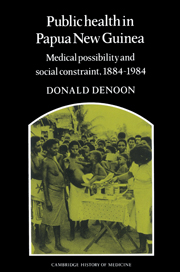Book contents
- Frontmatter
- Contents
- Acknowledgements
- Maps of Papua New Guinea
- Introduction
- I The rise and fall of tropical medicine
- II The rise and fall of the great campaigns
- 8 Miracle drugs, new perceptions and the post-war Public Health Department
- 9 The health campaigns
- 10 Women and children last
- 11 Health education
- 12 A national health system
- 13 Primary health care
- 14 The past and the future
- Notes
- Bibliography
- Index
10 - Women and children last
Published online by Cambridge University Press: 11 February 2010
- Frontmatter
- Contents
- Acknowledgements
- Maps of Papua New Guinea
- Introduction
- I The rise and fall of tropical medicine
- II The rise and fall of the great campaigns
- 8 Miracle drugs, new perceptions and the post-war Public Health Department
- 9 The health campaigns
- 10 Women and children last
- 11 Health education
- 12 A national health system
- 13 Primary health care
- 14 The past and the future
- Notes
- Bibliography
- Index
Summary
Much of the history of medical administration in Papua New Guinea may be read as the local application of universally agreed prescriptions. In one major area of therapy, however, there was variation within the country. At the risk of over-stating the contrast, it is convenient to present the work of the post-war medical missions as complementary to the department's work.
The department was, of course, responsible for the whole country, and the careers of doctors, nurses, and medical assistants (but not aid post orderlies) took them from one district to another, from rural extension work to headquarters administration or to research duties. Though the hospitals and health centres were fixed, the personnel were highly mobile. Each mission, on the other hand, ministered to a circumscribed area, and careers involved long periods in a single language community. Immobility (often intensified by isolation from other expatriates) encouraged familiarity with the language and society of the neighbourhood. Mission personnel who wished to specialise, commonly transferred to the department. Other kinds of specialisation – for instance Ed Tscharke's study of yaws – might entrench a mission worker ever more deeply in one locality. Tscharke built his own hospital on Karkar island, and ran it for thirty years, specialising in yaws treatment.
In the immediate aftermath of war, the missions were financially straitened: their personnel accepted lower salaries than their departmental counterparts, and they managed without expensive technology.
- Type
- Chapter
- Information
- Public Health in Papua New GuineaMedical Possibility and Social Constraint, 1884–1984, pp. 85 - 92Publisher: Cambridge University PressPrint publication year: 1989



